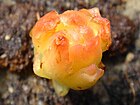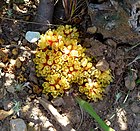Note: This is a project under development. The articles on this wiki are just being initiated and broadly incomplete. You can Help creating new pages.
Difference between revisions of "Cytinus hypocistis"
(→Photo Gallery) |
|||
| (10 intermediate revisions by 2 users not shown) | |||
| Line 1: | Line 1: | ||
[[File:Cytinus.ruber.jpg|thumb|right|''Cytinus'']] | [[File:Cytinus.ruber.jpg|thumb|right|''Cytinus'']] | ||
| − | + | '''Cytinus hypocistis''' is a genus of parasitic [[Flowering plant]]s. Species in this genus do not produce chlorophyll but rely fully on its host plant. It has also been found on Ptilostemon chamaepeuce. | |
| − | '''Cytinus''' is a genus of parasitic [[Flowering plant]]s. Species in this genus do not produce chlorophyll | ||
| − | |||
==Uses== | ==Uses== | ||
{{Uses|Wounds}}, {{Uses|Cuts}}, {{Uses|Snakebites}}, {{Uses|Curing liver disorders}}, {{Uses|Skin eruptions}}, {{Uses|Blotches}}, {{Uses|Pimples}}, {{Uses|Diarrhea}}, {{Uses|Sore throats}}<ref name="Uses"/> | {{Uses|Wounds}}, {{Uses|Cuts}}, {{Uses|Snakebites}}, {{Uses|Curing liver disorders}}, {{Uses|Skin eruptions}}, {{Uses|Blotches}}, {{Uses|Pimples}}, {{Uses|Diarrhea}}, {{Uses|Sore throats}}<ref name="Uses"/> | ||
==Parts Used== | ==Parts Used== | ||
| − | {{Parts Used|Dried | + | {{Parts Used|Dried folaige}}, {{Parts Used|Whole herb}}. |
==Chemical Composition== | ==Chemical Composition== | ||
| Line 26: | Line 24: | ||
===Fruit=== | ===Fruit=== | ||
| − | {{Fruit||7–10 mm (0.28–0.4 in.) long pome| | + | {{Fruit||7–10 mm (0.28–0.4 in.) long pome|Clearly grooved lengthwise, Lowest hooked hairs aligned towards crown|With hooked hairs|}} |
===Other features=== | ===Other features=== | ||
==List of Ayurvedic medicine in which the herb is used== | ==List of Ayurvedic medicine in which the herb is used== | ||
| − | |||
==Where to get the saplings== | ==Where to get the saplings== | ||
| Line 38: | Line 35: | ||
==How to plant/cultivate== | ==How to plant/cultivate== | ||
| − | |||
==Commonly seen growing in areas== | ==Commonly seen growing in areas== | ||
| − | |||
==Photo Gallery== | ==Photo Gallery== | ||
<gallery class="left" caption="" widths="140px" heights="140px"> | <gallery class="left" caption="" widths="140px" heights="140px"> | ||
File:Cytinus hypocistis.jpg | File:Cytinus hypocistis.jpg | ||
| − | + | File:Cytinus hypocistis 1.jpg | |
| − | + | File:Cytinus hypocistis-.jpg | |
| − | + | File:Cytinus hypocistis . - CYTINACEAE - Flickr - gailhampshire.jpg | |
</gallery> | </gallery> | ||
==References== | ==References== | ||
| − | |||
<references> | <references> | ||
| − | <ref name="chemical composition">[https://www.sciencedirect.com/science/article/pii/S0378874112006393?via%3Dihub | + | <ref name="chemical composition">[https://www.sciencedirect.com/science/article/pii/S0378874112006393?via%3Dihub Sciencedirect]</ref> |
| − | + | <ref name="Leaf">[https://web.archive.org/web/20131226161459/http://www.wildflowers-guide.com/39-agrimony.html Wayback machine]</ref> | |
| − | <ref name="Leaf">[https://web.archive.org/web/20131226161459/http://www.wildflowers-guide.com/39-agrimony.html | + | <ref name="Uses">[http://www.homeremediess.com/agrimonia-eupatoria-medicinal-uses-and-images/ Traditional medicine]</ref> |
| − | |||
| − | <ref name="Uses">[http://www.homeremediess.com/agrimonia-eupatoria-medicinal-uses-and-images/ | ||
| − | |||
| − | |||
</references> | </references> | ||
==External Links== | ==External Links== | ||
| + | * [https://www.first-nature.com/flowers/cytinus-hypocistis.php Cytinus hypocistis on first-nature.com] | ||
| + | * [https://www.ncbi.nlm.nih.gov/pmc/articles/PMC4603636/ Cytinus hypocistis on ncbi.nlm.nih.gov] | ||
[[Category:Herbs]] | [[Category:Herbs]] | ||
| + | [[Category:Cytinaceae]] | ||
Latest revision as of 09:32, 23 April 2020
Cytinus hypocistis is a genus of parasitic Flowering plants. Species in this genus do not produce chlorophyll but rely fully on its host plant. It has also been found on Ptilostemon chamaepeuce.
Contents
Uses
Wounds, Cuts, Snakebites, Curing liver disorders, Skin eruptions, Blotches, Pimples, Diarrhea, Sore throats[1]
Parts Used
Chemical Composition
Contains volatile oils, flavonoids, apigenin, luteolin, quercetin, kaempferol, tiliroside, triterpene glycosides including euscapic acid and tormentic acid, phenolic acids, and 3%–21% tannins.[2]
Common names
| Language | Common name |
|---|---|
| Kannada | |
| Hindi | |
| Malayalam | |
| Tamil | |
| Telugu | |
| Marathi | NA |
| Gujarathi | NA |
| Punjabi | NA |
| Kashmiri | NA |
| Sanskrit | |
| English | Cytinus |
Habit
Identification
Leaf
| Kind | Shape | Feature |
|---|---|---|
| Simple | The leaves are divided into 3-6 toothed leaflets, with smaller leaflets in between |
Flower
| Type | Size | Color and composition | Stamen | More information |
|---|---|---|---|---|
| Unisexual | 2-4cm long | Yellow | 5-20 | Flowers Season is June - August |
Fruit
| Type | Size | Mass | Appearance | Seeds | More information |
|---|---|---|---|---|---|
| 7–10 mm (0.28–0.4 in.) long pome | Clearly grooved lengthwise, Lowest hooked hairs aligned towards crown | With hooked hairs | {{{6}}} |
Other features
List of Ayurvedic medicine in which the herb is used
Where to get the saplings
Mode of Propagation
How to plant/cultivate
Commonly seen growing in areas
Photo Gallery
References
External Links
Categories:
- Ayurvedic Herbs known to be helpful to treat Wounds
- Ayurvedic Herbs known to be helpful to treat Cuts
- Ayurvedic Herbs known to be helpful to treat Snakebites
- Ayurvedic Herbs known to be helpful to treat Curing liver disorders
- Ayurvedic Herbs known to be helpful to treat Skin eruptions
- Ayurvedic Herbs known to be helpful to treat Blotches
- Ayurvedic Herbs known to be helpful to treat Pimples
- Ayurvedic Herbs known to be helpful to treat Diarrhea
- Ayurvedic Herbs known to be helpful to treat Sore throats
- Herbs with Dried folaige used in medicine
- Herbs with Whole herb used in medicine
- Herbs with common name in English
- Habit - Herb
- Index of Plants which can be propagated by Seeds
- Index of Plants which can be propagated by Cuttings
- Herbs
- Cytinaceae




